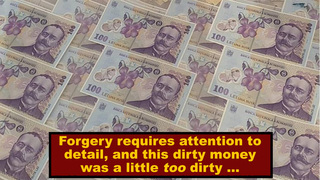A Fingerprint Inside Of A Banknote Caught Romania's Greatest Counterfeiter

One of Romania's greatest points of pride, aside from its cabbage rolls, is that it was the first country to switch to polymer banknotes in 1999. The upsides were obvious: Plastic money is much more durable and, more importantly, much harder to counterfeit, leading to less than 1% of their plasti-cash being counterfeited.
But what the Romanian failed to anticipate was that their early adoption would simply create a finer breed of criminal. At the very top of that 1% of counterfeiters was a mastermind who, according to Romanian police, "managed to produce the best counterfeits in Romanian history and became the largest counterfeiter of plastic banknotes in the world." His 100 lei bills (about $24) could fool all but the most sophisticated forensic technology and looked and felt so much like the real deal that people referred to them as Super Lei.

If his counterfeiting was flawless, so was his gang's criminal operation. Hustlers would scout local fairs and events looking for especially "gullible" traveling vendors, keeping their phones turned off to avoid being tracked. Since "itnesses were not able to give any information about the notes because no one realized they had been handed a fake," the gang was able to elude the police for six years, passing off over 1,7 million lei or $440,000.
Don't Miss
But forgery requires pristine attention to detail, and it turned out that this counterfeiter's dirty money was a little too ... dirty. A technician spotted that one of the 17,000 fake notes had a smudge -- not on the note, but inside of it. That smudge turned out to be a partial fingerprint perfectly preserved and pressed in between the layers of polymer. Since only a handful of people could have poked around the insides of a counterfeit bill, this led to the arrest of three Super Lei gang members including the counterfeit ringleader himself, identified in the media only as C.R.T. -- which we'll assume stands for Counterfeiter Regrets Touching.
For more weird tangents and dirty money talk, do follow Cedric on Twitter.
Top Image: Directorate for Investigating Organized Crime and Terrorism